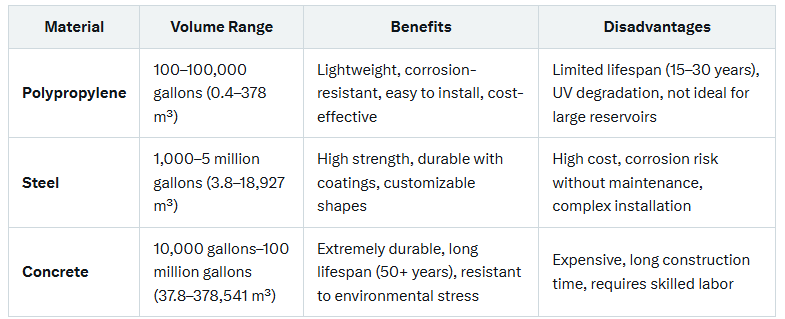Comparing Polypropylene, Steel, and Concrete for Water Storage Reservoirs
Water storage reservoirs are vital for managing water supply, irrigation, and flood control. Choosing the right material—polypropylene, steel, or concrete—impacts the reservoir’s durability, cost, and performance. This blog post compares these materials, focusing on their volume ranges, benefits, and disadvantages, presented in a clear, two-column layout for easy comparison.
CIVIL DESIGN
5/27/20252 min read


Selecting the appropriate material for a water storage reservoir ensures longevity, safety, and cost-effectiveness. Polypropylene, steel, and concrete each offer unique properties suited to different project needs. Below, we explore their volume capacities, advantages, and challenges to help you make an informed decision
Here’s a side-by-side comparison of polypropylene, steel, and concrete for water storage reservoirs, including their typical volume ranges and key characteristics.
Polypropylene
Volume Range: Best suited for small to medium reservoirs (100–100,000 gallons). Commonly used for modular tanks or liners in smaller water storage systems.
Benefits:
Cost-Effective: Lower initial costs compared to steel or concrete, ideal for budget-conscious projects.
Corrosion Resistance: Immune to rust and chemical degradation, perfect for storing potable water.
Ease of Installation: Lightweight and modular, reducing labor and setup time.
Flexibility: Can be used as liners or standalone tanks in various shapes.
Disadvantages:
Limited Lifespan: Typically lasts 15–30 years due to UV exposure and material fatigue.
Size Constraints: Not practical for large-scale reservoirs due to structural limitations.
Temperature Sensitivity: May deform under extreme heat or cold, requiring additional insulation.
Best Use Case: Small-scale water storage for farms, communities, or temporary setups.
Steel
Volume Range: Suitable for medium to large reservoirs (1,000–5 million gallons). Often used in bolted or welded tanks for municipal or industrial applications.
Benefits:
High Strength: Can withstand significant water pressure and external loads.
Customizability: Available in various sizes and shapes, with coatings (e.g., glass-fused-to-steel) for added durability.
Recyclable: Steel tanks can be repurposed or recycled at the end of their life.
Quick Assembly: Bolted steel tanks are faster to install than concrete.
Disadvantages:
Corrosion Risk: Requires protective coatings (e.g., epoxy or galvanization) and regular maintenance to prevent rust.
High Cost: More expensive than polypropylene, with costs rising for larger tanks or specialized coatings.
Installation Complexity: Welded tanks require skilled labor and heavy equipment.
Best Use Case: Municipal water storage or industrial applications needing robust, mid-sized reservoirs.
Concrete
Volume Range: Ideal for large-scale reservoirs (10,000 gallons–100 million gallons). Used in dams, large municipal tanks, or underground cisterns.
Benefits:
Exceptional Durability: Lasts 50–100 years with minimal maintenance, resisting environmental stressors like earthquakes or floods.
Versatility: Can be cast in various shapes, suitable for both above-ground and underground reservoirs.
Thermal Stability: Maintains structural integrity in extreme temperatures.
Low Maintenance: Resistant to corrosion and UV damage, reducing long-term costs.
Disadvantages:
High Initial Cost: Expensive due to materials, labor, and construction time.
Long Construction Time: Requires significant planning and curing periods, delaying project completion.
Cracking Risk: Poor construction or seismic activity can lead to cracks, requiring repairs.
Best Use Case: Large-scale municipal or agricultural reservoirs requiring long-term reliability.
Selecting the best material depends on your project’s needs:
Budget Constraints: Polypropylene is the most affordable for small-scale projects, while steel and concrete require larger investments.
Volume Requirements: For small tanks (<100,000 gallons), polypropylene is ideal; steel suits mid-sized projects, and concrete excels for massive reservoirs.
Environmental Factors: Concrete and steel handle harsh climates better, while polypropylene needs UV protection.
Maintenance Capacity: Concrete requires the least upkeep, followed by polypropylene, while steel demands regular inspections.
Pro Tip: Conduct a site analysis to assess soil, climate, and water chemistry. Consult standards from organizations like the American Water Works Association (AWWA) to ensure compliance.
Polypropylene, steel, and concrete each offer distinct advantages for water storage reservoirs. Polypropylene is a cost-effective, flexible choice for smaller systems, steel provides strength and scalability for mid-sized projects, and concrete delivers unmatched durability for large-scale infrastructure. By evaluating your project’s volume needs, budget, and environmental conditions, you can select the material that ensures a reliable and sustainable reservoir
